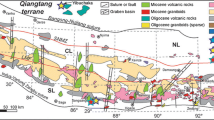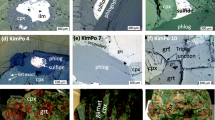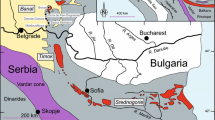Abstract
We present evidence for a thick (∼100 km) sequence of cogenetic rocks which make up the root of the Sierra Nevada batholith of California. The Sierran magmatism produced tonalitic and granodioritic magmas which reside in the Sierra Nevada upper- to mid-crust, as well as deep eclogite facies crust/upper mantle mafic–ultramafic cumulates. Samples of the mafic–ultramafic sequence are preserved as xenoliths in Miocene volcanic rocks which erupted through the central part of the batholith. We have performed Rb-Sr and Sm-Nd mineral geochronologic analyses on seven fresh, cumulate textured, olivine-free mafic–ultramafic xenoliths with large grainsize, one garnet peridotite, and one high pressure metasedimentary rock. The garnet peridotite, which equilibrated at ∼130 km beneath the batholith, yields a Miocene (10 Ma) Nd age, indicating that in this sample, the Nd isotopes were maintained in equilibrium up to the time of entrainment. All other samples equilibrated between ∼35 and 100 km beneath the batholith and yield Sm-Nd mineral ages between 80 and 120 Ma, broadly coincident with the previously established period of most voluminous batholithic magmatism in the Sierra Nevada. The Rb-Sr ages are generally consistent with the Sm-Nd ages, but are more scattered. The 87Sr/86Sr and 143Nd/144Nd intercepts of the igneous-textured xenoliths are similar to the ratios published for rocks outcroping in the central Sierra Nevada. We interpret the mafic/ultramafic xenoliths to be magmatically related to the upper- and mid-crustal granitoids as cumulates and/or restites. This more complete view of the vertical dimension in a batholith indicates that there is a large mass of mafic–ultramafic rocks at depth which complement the granitic batholiths, as predicted by mass balance calculations and experimental studies. The Sierran magmatism was a large scale process responsible for segregating a column of ∼30 km thick granitoids from at least ∼70 km of mainly olivine free mafic–ultramafic residues/cumulates. These rocks have resided under the batholith as granulite and eclogite facies rocks for at least 70 million years. The presence of this thick mafic–ultramafic keel also calls into question the existence of a “flat” (i.e., shallowly subducted) slab at Central California latitudes during Late Cretaceous–Early Cenozoic, in contrast to the southernmost Sierra Nevada and Mojave regions.
Similar content being viewed by others
Author information
Authors and Affiliations
Additional information
Received: 27 December 1997 / Accepted: 11 June 1998
Rights and permissions
About this article
Cite this article
Ducea, M., Saleeby, J. The age and origin of a thick mafic–ultramafic keel from beneath the Sierra Nevada batholith. Contrib Mineral Petrol 133, 169–185 (1998). https://doi.org/10.1007/s004100050445
Published:
Issue Date:
DOI: https://doi.org/10.1007/s004100050445




